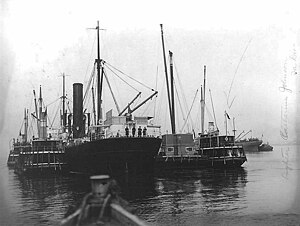| This article includes a list of references, related reading, or external links, but its sources remain unclear because it lacks inline citations. Please help improve this article by introducing more precise citations. (March 2022) (Learn how and when to remove this message) |
 A pre-World War I photograph of George H. Johnson (left) and Catherine Johnson, (right) loading or unloading barrels. A pre-World War I photograph of George H. Johnson (left) and Catherine Johnson, (right) loading or unloading barrels.
| |
| History | |
|---|---|
| Name | USS George H. Johnson (proposed) |
| Namesake | Previous name retained (proposed) |
| Builder | W. G. Abbott, Milford, Delaware |
| Completed | 1912 |
| Acquired | Never |
| Commissioned | Never |
| Notes | No naval service; operated as commercial freight lighter George H. Johnson |
| General characteristics | |
| Type | Patrol vessel (proposed) |
| Tonnage | 196 gross register tons |
| Length | 110 ft (34 m) |

USS George H. Johnson (SP-379) was the proposed name and designation for a freight lighter that the United States Navy considered for World War I naval service but never acquired.
George H. Johnson was built as a commercial freight lighter in 1912 by W. G. Abbott at Milford, Delaware. She was the property of the T. Johnson Company of New York City when the U.S. Navy inspected her in 1916 or early 1917 for possible naval use during World War I. The Navy assigned her the section patrol number SP-379 but never acquired her, and she saw no naval service.
References
- NavSource Online: Section Patrol Craft Photo Archive: George H. Johnson (SP-379) Archived 2011-04-27 at the Wayback Machine